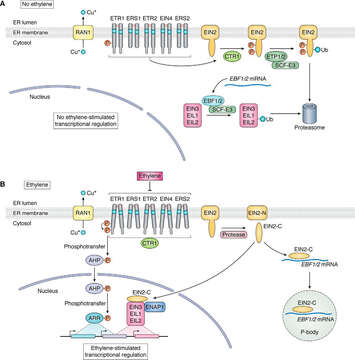Ethylene signaling pathway

Description:
Description: English: Model for ethylene signaling. RAN1 is a copper transporter that delivers copper to the lumen of the ER, where it is required for the biogenesis of the receptors and is used as a cofactor by the receptors to bind ethylene. A, in the absence of ethylene, the receptors signal to CTR1, which phosphorylates EIN2. This results in the ubiquitination of EIN2 by an SCF E3 containing the ETP1/2 F-box proteins, leading to EIN2 degradation by the proteasome. Because EIN2 levels are low, an SCF-E3 containing the EBF1/2 F-box proteins ubiquitinates EIN3 and EIL1, leading to their degradation by the proteasome and preventing them from affecting transcription in the nucleus. B, in the presence ethylene, the receptors bind ethylene via a copper cofactor. The binding of ethylene is modeled to cause a conformational change that either reduces CTR1 kinase activity or, as shown, results in CTR1 being sequestered by the receptors so that CTR1 can no longer phosphorylate EIN2. The reduction in EIN2 phosphorylation results in less EIN2 ubiquitination and an increase in EIN2 levels. An unknown protease cleaves EIN2, releasing the C-terminal end (EIN2-C) from the N-terminal end (EIN2-N). One fate of EIN2-C is to bind the RNAs for EBF1 and EBF2 and become sequestered in processing bodies (P-bodies). The reduction of EBF1/2 results in less ubiquitination of EIN3 and EIL1, causing higher EIN3/EIL1 levels. The other fate of EIN2-C is to translocate to the nucleus, where it increases the transcriptional activity of EIN3/EIL1 via ENAP1. This leads to numerous transcriptional changes. In parallel with this pathway, phosphoryl transfer from a conserved histidine in the ETR1 DHp domain to an aspartate in the receiver domain occurs. This is followed by phosphoryl transfer from this residue to AHPs and finally ARRs resulting in transcriptional changes. Date: 29 May 2020. Source: Binder B. M. (2020). Ethylene signaling in plants. The Journal of biological chemistry, 295(22), 7710–7725. https://doi.org/10.1074/jbc.REV120.010854. Author: Brad M. Binder.
Included On The Following Pages:
- Life (creatures)
- Cellular (cellular organisms)
- Eukaryota (eukaryotes)
- Archaeplastida (plants)
- Chloroplastida (green plants)
- Streptophyta
- Embryophytes
- Tracheophyta (ferns)
- Spermatophytes (seed plants)
- Angiosperms (Dicotyledons)
- Eudicots
- Superrosids
- Rosids
- Brassicales
- Brassicaceae (crucifers)
- Arabidopsis (rockcress)
- Arabidopsis thaliana (Mouse-ear Cress)
This image is not featured in any collections.
Source Information
- license
- cc-by-sa-3.0
- copyright
- Brad M. Binder
- original
- original media file
- visit source
- partner site
- Wikimedia Commons
- ID


